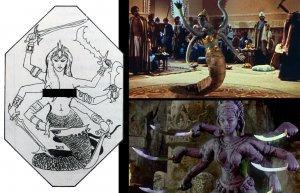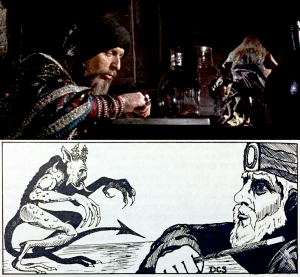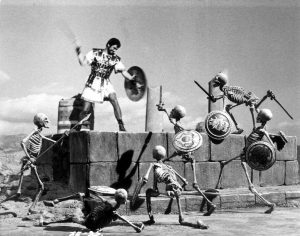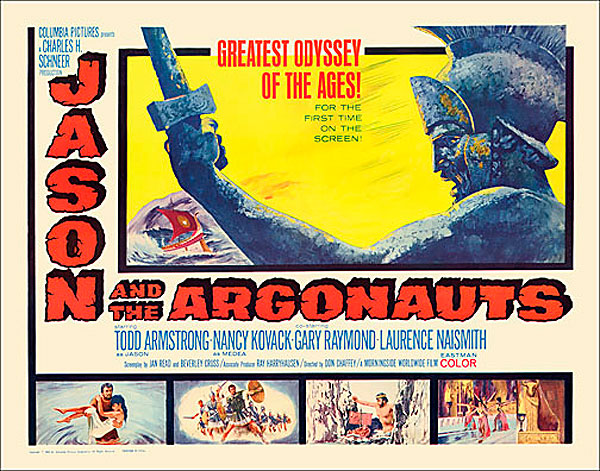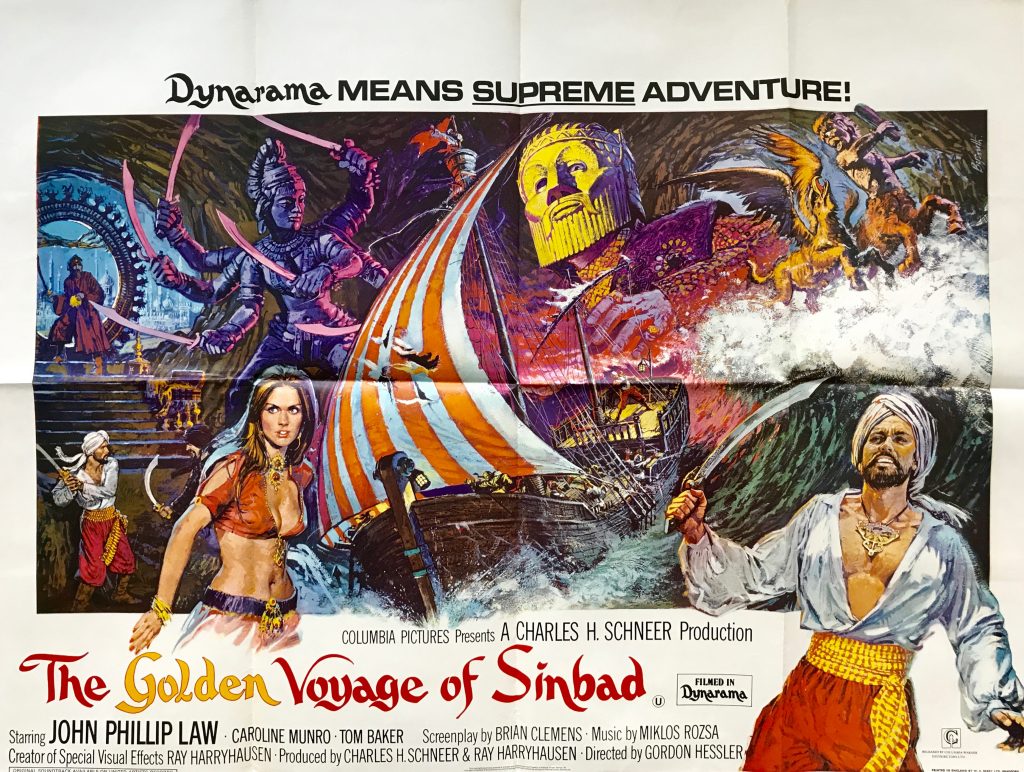
Films of High Adventure: Ray Harryhausen and the Look of Fantasy
by Brett Brooks
Here at Goodman Games, we have long honored the role of Appendix N and its influence on not just Dungeons and Dragons, but fantasy role-playing as a whole—including Dungeon Crawl Classics. We also feel that there are others who played a role that deserve the same recognition as those that Mr. Gygax listed in the Dungeon Master’s Guide, and they can come from many different media.
June 29th celebrates what would have been Ray Harryhausen’s 100th birthday. As one of the most celebrated special effects wizards in the history of cinema, his impact on filmmaking goes beyond reproach. Many of the most talented directors of the last fifty years directly cite him as a profound influence, including Peter Jackson, Guillermo del Toro, James Cameron, Edgar Wright, and Steven Spielberg. But what about role-playing games? How did he affect those? We’ll discuss that in a moment, but first, some background.
Ray Harryhausen’s career began under the tutelage of another master of cinematic effects, Willis O’Brien. O’Brien is best known as the special effects creator on the original King Kong film, which inspired Harryhausen while he was in high school. He arranged a meeting with O’Brien, took some sculptures of his dinosaurs, and O’Brien kept Harryhausen on his radar from there out. During that same time, Harryhausen became close friends with another creator who would rise to prominence, a writer by the name of Ray Bradbury. During WWII, he served under an aspiring film maker named George Pal, who then introduced him to another director working for the military, Frank Capra. Capra recruited him for the SCPC, the Special Service division, helping him make films for the US Government throughout the war. On some of those films—most notably one entitled Snafu—he worked with another up-and-coming talent named Theodore Giesel (better known as Dr. Seuss). After the war, Harryhausen and O’Brien first worked together on the Academy Award winning Mighty Joe Young. And the rest, as they say, is history.
And if his story ended there, it would certainly be enough—but of course, it doesn’t. The visuals and dynamics created by Harryhausen weighed heavily on the minds of others, which evidence indicates included the imaginations of Gary Gygax and the other people responsible for the creation of Dungeons and Dragons.
Ray Harryhausen is credited as being the special effects wizard on sixteen films, and all of them are worth note. Hints and touches from each of them work their way into various aspects of fantasy role-playing, but there are four films in particular that I want to talk about today.
The mention of Harryhausen’s name instantly causes many to think of his work on the series of three Sinbad films and the fantasy sequences they contained. The first movie in that series, The 7th Voyage of Sinbad (1958), contains battles between a group of heroes and a roc, a cyclops, a skeletal warrior, and (of course) a dragon—not all at the same time. These heroes fight their way through all of these menaces to rescue a princess from an evil wizard. Any of this sounding familiar? And while the formula might be one that can be seen elsewhere, it is the visuals of his films that most clearly reflect his creations.
It was over a decade between the first and the second release of the series, The Golden Voyage of Sinbad (1973). The proximity between the release of The Golden Voyage of Sinbad and the original release of Dungeons and Dragons in 1974 puts an added weight to the visual impact this film carried. In Golden Voyage one of Harryhausen’s most iconic scenes occurs as Sinbad and his crew battle against the animated statue of Kali. The six-armed creature wields a sword in each hand and simultaneously combats several people at once. A decade-and-a-half earlier in 7th Voyage of Sinbad, the crew watches a four-armed serpent woman dance. You put those two in a blender and you pour out the very image of the Type V demon from the original Monster Manual. A perfect blend of Harryhausen to create one of D&D’s most iconic visuals.
And while not one of the more renowned sequences, a scene of the wizard and his homunculus from The Golden Voyage of Sinbad does carry a strong resemblance to the image presented for the quasit in the Monster Manual. Sure, it might not be named the homunculus in the book, but you cannot deny the images look very similar.
Sinbad and the Eye of the Tiger from 1977 clearly didn’t impact the original release of D&D, nor did it feature the creatures of fantasy that the previous two films highlighted, but it’s hard not to think of a smilodon without seeing the look of the one created by Harryhausen in that movie. (We won’t even talk about the Brass Golem from Monstrous Compendium Annual Volume 4 and how it looks like the Minoton from the movie—but we just did.)
Yet, with all of the other films and their impact, it is one movie that perhaps had the greatest influence on fantasy role-playing. That film is 1963’s Jason and the Argonauts. It’s a veritable treasure trove of D&D imagery brought to life a decade before Dungeons and Dragons came into existence. The design of the harpies in the Monster Manual are very reminiscent of those from the film—though Harryhausen’s were slightly more family-friendly. While the one in the Monster Manual had legs, the shape of the hydra’s head from Jason also seems very similar (and uncannily so in the later Pathfinder books). And perhaps the most clear translation of any image is in the initial appearance of the great metal giant, Talos, as he resides on top of the tomb being raided by Hercules and Hylas. Compare it to the drawing of the iron golem from the original Monster Manual. They could play twins in an off-Broadway production of How I Met Your Mimic.
And for many, the peak of Harryhausen’s career happened with the climactic scene of Jason and the Argonauts—the skeletal battle. In the film, the wizard opposing Jason casts forth the hydra’s teeth to summon up a group of skeletons, and then commands them to attack Jason and his crew. The Monster Manual describes the skeleton as “enchanted by a powerful magic-user or cleric…[who] perform according to the command of their animator—the command being limited in scope to but a dozen or two words.” Almost a description of fight scene to the letter.
While Harryhausen is not declared the director of any of his films, it is clear who the driving force behind those movies is at their heart. All of Harryhausen’s movies carry with them the same wonder and amazement that everyone tries to summon forth when sitting around a table with a set of dice and a group of friends. And it is not the director of those films that is remembered, they are referred to as Harryhausen films for a reason.
On his blog, writer Stephen D. Sullivan had this to say about Ray Harryhausen and his impact: “He also influenced today’s video game business, either directly (ever battled a dragon in a video game?) or indirectly, through his influence on Dungeons & Dragons and the other games that were the progenitors to that industry. (And, being part of the early D&D creative team, I guarantee that Ray’s influence on those games is very real.)” He further goes on to state that Harryhausen didn’t change just our outlook on fantasy, but the very world itself.
It’s hard to argue with that statement. The imagery of the world around us and those that we can only imagine have been forever altered by the visions of one man. And we are very lucky to have had Ray Harryhausen come along, because his creations are a thing of beauty.
So, if you are looking for some inspiration, you can turn on one of the latest fantasy films or television shows that have been cranked out in a week or two, or you can look to the work of Ray Harryhausen and go a little old school. Around here, we’re a little partial to that last idea.



